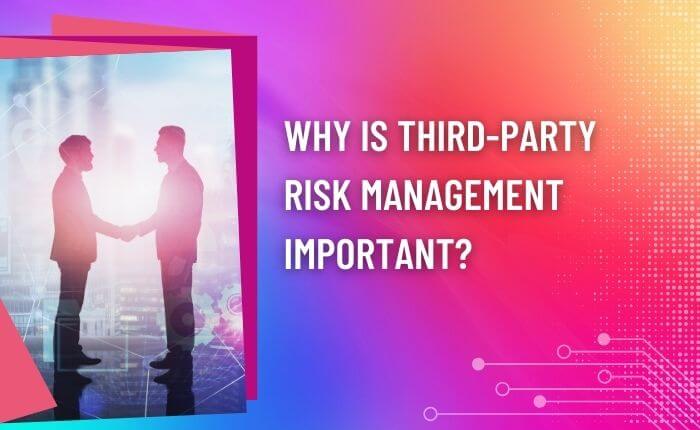USA: +1 (551) 242-2980 | India: 1800 102 1532 (Toll Free)
A single data breach can completely upend a business, you can’t afford to be sloppy.
Over 155 million people were negatively impacted by data breaches in 2020. Alongside sensitive information being taken, a poorly protected business can also be susceptible to hacking and reputational damage. This is where third-party risk management comes into play.
Third-party risk management is important and you need it now more than ever. Keep reading to learn how you can protect your business.

Logic dictates you can’t protect what you don’t know about. Third-party risk management is the act of studying and preventing risks that come with working with third parties.
Business is an ongoing collaboration and nowhere is this more clear than with third parties. If you’ve ever worked with a marketing agency or installed a credit card vendor system, you’re already familiar with the function of a third party.
Understand Exactly What Risks You Face, and Get Help Protecting Your Business contact IARM today for more information
The goal of third-party risk management is to keep you free from data breaches and hacking attempts. Cyber security is of the utmost importance and an aspect you should focus on when investing in third-party risk management.
Did you know 80% of today’s IT leaders believe their organizations don’t have sufficient cybersecurity protection? When even technological movers and shakers aren’t confident in their tools, you know third-party risk management is a vital tool.
A single data breach can expose all the personal information of your employees and customers. This includes home addresses, credit card reports, and creative licenses not ready for public consumption.
Other security issues include malware, spyware, and ransomware. While a digitally connected world is convenient and fast-paced, it has the downside of making cyber security attacks easier to commit.
Startups are particularly vulnerable to data breaches and they regularly find their sensitive intellectual property compromised.
Related: The Importance Of Cybersecurity In The Healthcare Industry
While cybersecurity is complex, measuring its safety is surprisingly straightforward. You can measure third-party risk by studying its security ratings.
Similar to credit card scores, these security ratings are designed to inform interested businesses of the benefits (or negatives) of partnering with a third party. Security rating providers provide regularly updated ratings to give you a good idea of what it’s like to partner with a certain vendor or contractor.
It’s also a good idea to reach out to trusted professionals in your network and ask them for their thoughts. The more information you have on a third party, the better off you are.
Do you have an effective security plan in place before any attack can happen? IARM offers Vulnerability Assessments, Penetration Testing, SOC, Industrial Cybersecurity, Cloud Security, Compliance Audits and more!
Sadly, not nearly enough businesses invest the right amount of money and time into third-party risk management. With so many responsibilities on their plate, investing in cybersecurity can fall to the bottom of the to-do list.
Common problems you may run into with third-party risk management include:
Related: BCP Simplified! Easy To Understand Business Continuity Plan
Shield your business from phishing, hacking, and intellectual property theft! Contact IARM today to learn about your risk factors and what security tool is best for you.
You may feel overwhelmed by all the information on display, but there’s some good news. Now is the best time to implement a thorough third-party risk management program.
You can’t improve your business unless you know what is and isn’t working behind-the-scenes. Your third-party risk management program should have a reporting protocol that provides you automated reports. This will ensure no risk escapes your notice and you’re getting the most out of your investment.
Who is in charge of overseeing the third-party risk management software? Who is responsible for reporting risks? Your business needs to make sure everyone knows what their job is, because a lack of accountability only breeds chaos.
Having a defined process will take the drudgery out of risk management. Create a simple list of necessary, automated duties to ensure you’re getting the most out of your program.
Related: The Importance Of Security Checks During Vendor Risk Assessment
Third-party risk management is your bulwark against an unpredictable world. It’s designed to prevent the worst from happening, rather than leave your business up to chance.
Investing in a third-party risk management system is simple when you implement a framework, define clear roles in your organization, and keep a close eye on your tools. While it will be another investment to keep track of, you’ll be glad you made the effort. Effective third-party risk management drastically reduces your risk of data breaches and pays for itself in the long run.
Keep your information safe from prying eyes. Contact IARM today to start implementing practical security solutions in your business framework.
Inquire Now